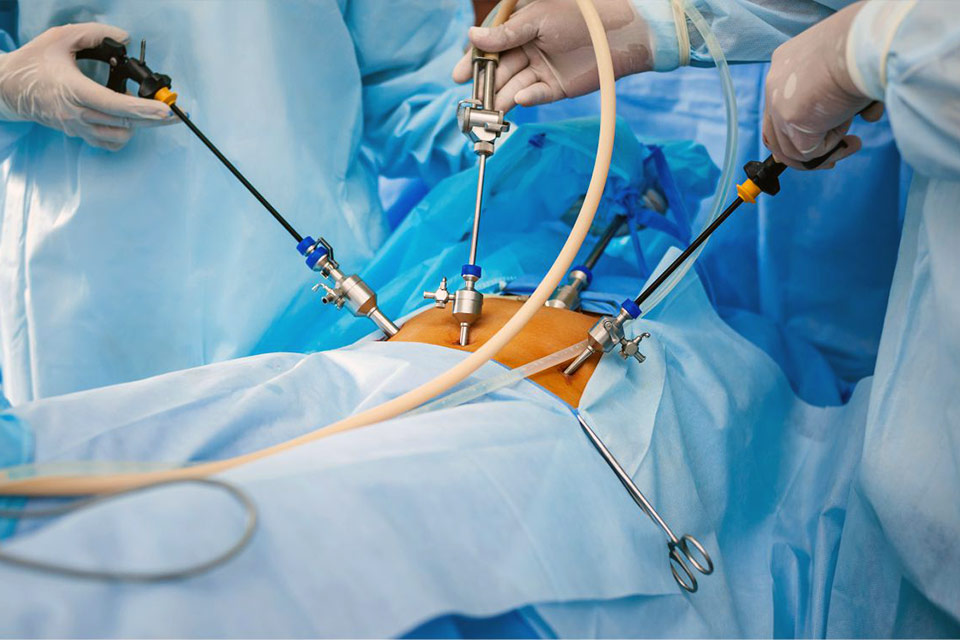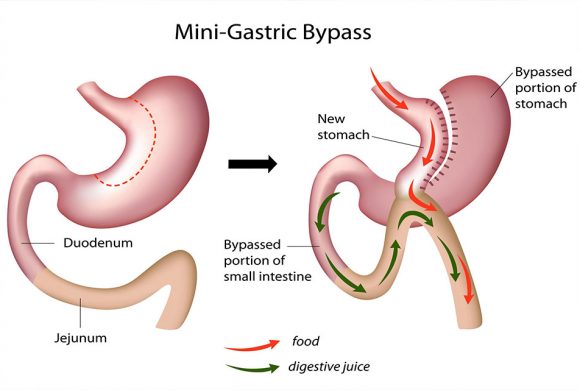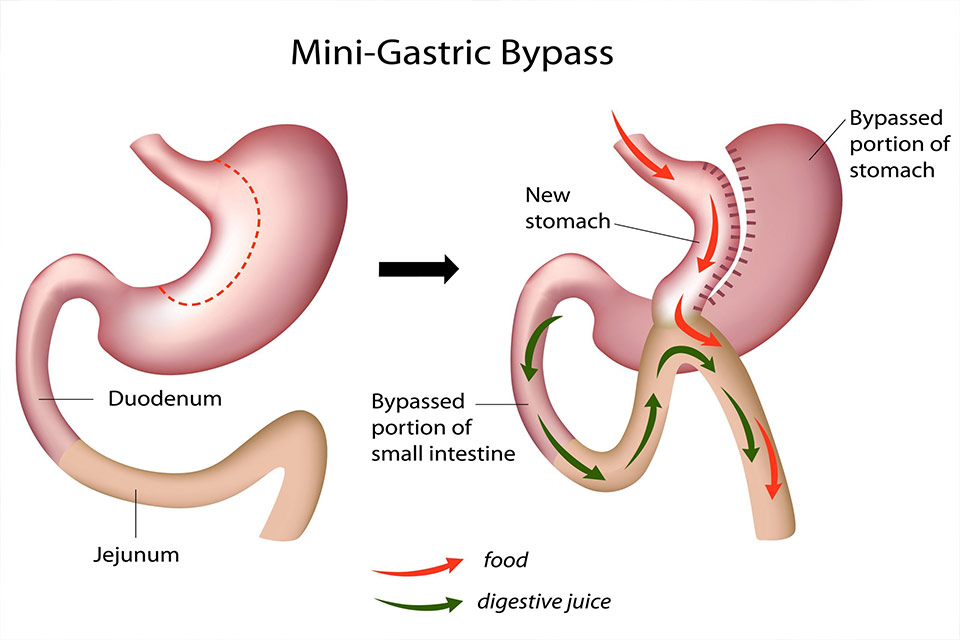What is Mini Gastric Bypass Surgery?
Mini Gastric Bypass is an operation performed in the easiest, shortest time among bariatric surgery operations, short hospital stay and at the most economical costs. Mini gastric Bypass surgery provides weight loss achieved by Standard bypass surgeries. It is an operation with high control power in cases such as Type 2 diabetes, hypertension and hyperlipidemia, which are the leading signs of metabolic syndrome.
Mini-Gastric Bypass, also known as single anastomosis gastric bypass, is a procedure that combines some features of tube stomach surgery and a standard gastric bypass. A long gastric bag is created, and then the formed gastric bag is combined with a part of the small intestine.

Here are some characteristics of mini gastric bypass surgery
- Simpler Procedure: Compared to the traditional gastric bypass, the mini gastric bypass is simpler because it involves fewer connections or anastomoses (hence the term “one-anastomosis gastric bypass”).
- Shorter Surgery Time: Because it’s a less complicated procedure, mini gastric bypass surgery often requires less time in the operating room.
- Comparable Weight Loss: Research suggests that mini gastric bypass can lead to similar or even greater weight loss compared to traditional gastric bypass.
- Potential for Reflux: Some studies suggest that mini gastric bypass surgery might have a higher risk of causing bile reflux gastritis, a condition where bile backs up into the stomach and causes irritation.
- Reversibility: Although it’s still a major surgery, some consider mini gastric bypass to be reversible because the stomach and small intestine aren’t permanently altered as they are in some other types of weight loss surgeries.
As with any surgical procedure, mini gastric bypass has risks, including infection, bleeding, and complications related to anesthesia. Longer-term risks can include nutritional deficiencies and complications related to the rerouting of the digestive system. Therefore, it’s crucial for anyone considering this surgery to have a thorough discussion with their healthcare provider about the potential risks and benefits.

What is the difference between a gastric bypass and a mini bypass?
Just as in the case of an RNY Gastric Bypass operation, the stomach is divided into two parts. The difference between RNY and Gastric Bypass is that the intestine connects to the stomach without dividing. Thus, in the Mini Gastric Bypass operation, one connection is made less in total. If the absorption is reduced, a longer intestinal section is bypassed in the Mini Gastric Bypass operation than in the RNY Gastric Bypass operation. Due to the fact that the remaining stomach fluids and the passage of bile in its continuation are the ends of the reduced stomach, there is a possibility of bile reflux during a Mini Gastric Bypass operation.
In none of the Gastric Bypass surgeries, the stomach is not removed, the stomach is reduced in itself. As a matter of fact, it is extremely advantageous in two operations. In both operations, it reduces the volume of the stomach and provides absorption. Thus, patients lose weight. He is successful at the stage of losing weight in two operations.
Gastric Bypass Surgery Procedure
Gastric bypass surgery, specifically Roux-en-Y gastric bypass, is a complex procedure that involves creating a small pouch from the stomach and connecting it directly to the small intestine. The procedure is typically done under general anesthesia and can be performed as open surgery (with a large incision) or laparoscopically (using small incisions and specialized tools). The laparoscopic method is less invasive and generally has a quicker recovery time.
- Anesthesia: You’ll be given general anesthesia, which means the operation will be performed while you’re asleep and you won’t feel pain.
- Making the incisions: The surgeon will either make a single large incision to open the abdomen (open surgery) or several small incisions (laparoscopic surgery).
- Creating the pouch: The surgeon will cut across the top of your stomach, sealing it off from the rest of your stomach, to create a small pouch. This significantly limits the amount of food you can eat and drink at one time.
- Bypass: The surgeon will cut the small intestine and sew part of it directly onto the pouch. Food and liquid you eat will now go from the pouch into this part of the intestine, bypassing most of your stomach and the first part of your small intestine (duodenum). Because of this, your body will absorb fewer calories.
- Reconnecting the intestines: The surgeon then sews the main part of the intestine further down. This allows the juices from the bypassed stomach and duodenum, which aid in digestion, to flow into the lower part of the small intestine, where they mix with the food.
- Closing the incisions: The incisions are then closed with sutures or surgical staples.
- Recovery: Post-surgery, you will need to follow a specific diet that begins with liquids, then progresses to pureed, soft foods, and finally more regular foods.
The procedure typically takes several hours to complete. Because it affects how your body handles food, it’s important to follow the dietary and lifestyle changes recommended by your healthcare team. As with any surgery, gastric bypass surgery carries some risk, including infection, bleeding, and complications from anesthesia, as well as specific risks related to this procedure such as malnutrition and dumping syndrome. Always discuss these potential risks and benefits with your healthcare provider before making a decision.
Advantages of Mini Gastric Bypass
Mini gastric bypass surgery, also known as one-anastomosis gastric bypass, is a type of weight loss surgery that has become increasingly popular due to its simplicity and effectiveness. Below are some potential advantages of mini gastric bypass surgery:
- Simplicity: Mini gastric bypass is a less complex procedure compared to the traditional gastric bypass surgery. It involves fewer connections or anastomoses (hence the term “one-anastomosis gastric bypass”), which can make it quicker and easier to perform.
- Shorter Operating and Recovery Time: Since it’s a simpler procedure, the operating time for a mini gastric bypass surgery is typically shorter than that of a traditional gastric bypass. This also often translates into a shorter hospital stay and recovery time.
- Effective Weight Loss: Several studies suggest that mini gastric bypass surgery can lead to significant weight loss, comparable to or sometimes even greater than that achieved with a traditional gastric bypass.
- Improvement in Comorbidities: Like other weight loss surgeries, mini gastric bypass can lead to improvements in obesity-related health conditions, such as type 2 diabetes, high blood pressure, sleep apnea, and more.
- Possibly Reversible: Some consider mini gastric bypass to be potentially reversible because the stomach and small intestine aren’t permanently altered as they are in some other types of weight loss surgeries.
However, it’s essential to remember that, like all surgeries, mini gastric bypass comes with risks and potential complications, including infection, bleeding, and complications from anesthesia. Longer-term risks can include nutritional deficiencies and complications related to the rerouting of the digestive system. Furthermore, some research suggests an increased risk of bile reflux, which can lead to gastritis or esophagitis, after mini gastric bypass compared to traditional gastric bypass. Always discuss the potential risks and benefits with your healthcare provider to make the best decision for your health.
Who is the Mini Gastric Bypass suitable for?
Mini gastric bypass surgery is a type of weight-loss procedure, and it’s typically recommended for individuals who are severely obese and have been unable to lose weight through traditional methods like diet and exercise.
- Body Mass Index (BMI): Candidates usually have a BMI of 40 or higher, which is considered to be severe or morbid obesity. Some individuals with a BMI between 35 and 40 may also be considered if they have serious weight-related health issues (comorbidities), such as type 2 diabetes, high blood pressure, sleep apnea, or heart disease.
- Failed Weight Loss Attempts: The surgery is generally considered when the individual has tried and failed to lose weight with diet, exercise, and behavior modification.
- Understanding of Surgery: It’s important that the individual fully understands the procedure and the need for a lifelong commitment to diet and lifestyle changes. Mini gastric bypass surgery can lead to significant weight loss, but success is dependent on an individual’s willingness to make these changes.
- Age: While there isn’t a specific age limit for mini gastric bypass, the individual’s overall health and ability to withstand surgery is an important consideration. Most surgeons perform bariatric surgery on individuals between the ages of 18 and 65, but it’s evaluated on a case-by-case basis.
As with any medical procedure, the suitability for surgery should be discussed thoroughly with a healthcare provider. The doctor will take into account the person’s overall health, potential benefits, risks, and the individual’s willingness and ability to comply with post-surgery lifestyle changes.
Risks of mini gastric bypass
- The necessity of using vitamins for life
- The need for careful application in people with stomach cancer in their family
- Dumping syndrome
- Stomach runoff of saffron from the liver creates excessive irritation in the stomach. In the Normal case, this condition is prevented by a special muscular system that controls the outflow of the stomach Nov. In a Mini gastric Bypass operation, the pyloric muscle remains dysfunctional on the stomach, which remains blind. Bile from the liver continues down, emptying into the stomach without any obstacles in front of it. For this reason, after Mini Gastric Bypass, patients are at risk of severe bile reflux and alkaline reflux gastritis.
- In Mini gastric Bypass surgery, the new stomach is created, while the old stomach remains closed inside as it is. Endoscopy cannot be performed after Mini Gastric Bypass surgery on this large part of the stomach, and in case of possible problems, the possibility of early diagnosis or non-surgical treatment is eliminated.
- The stomach is divided into two parts, while the neural stimulation of the remaining stomach is completely severed.
After Mini Gastric Bypass
- Mini Gastric Bypass is a method that is performed in the fastest, easiest way among the operations performed in obesity surgery and the healing process after the operation is quite comfortable.
- The hospital admission period after surgery is 3-4 days.
- Patients are usually kept in intensive care units for the first 1 – 2 days.
- After surgery, a tube can be placed from the nose to the stomach for 2-3 days to empty the contents of the stomach.
- In addition, patients are checked every three months and vitamin and mineral values are measured. Additional supplements are made when deficiency is seen.
Mini Gastric Bypass in Turkey
As of my last training data in September 2021, Turkey has become a popular destination for medical tourism, including bariatric procedures like mini gastric bypass surgery. Here are some potential advantages of getting a mini gastric bypass in Turkey:
- Cost: One of the main reasons people opt for bariatric surgery in Turkey is the cost. Medical procedures are often significantly cheaper in Turkey than in many other countries, even when factoring in travel and accommodation expenses.
- Quality of Care: Many Turkish hospitals and clinics are equipped with state-of-the-art medical equipment and adhere to international standards of care. The country’s healthcare system is known for its high standard of medical professionalism.
- Experienced Surgeons: Turkey boasts numerous skilled and experienced bariatric surgeons. Many of them have been trained in Western countries and are knowledgeable about the latest surgical techniques.
- All-Inclusive Packages: Many medical tourism agencies and hospitals in Turkey offer all-inclusive packages. These often include the cost of surgery, hospital stay, hotel accommodation, airport transfers, and sometimes even tours of local attractions.
- Short Waiting Times: Compared to many other countries, the waiting times for procedures like mini gastric bypass surgery can be significantly shorter in Turkey.
- Travel Opportunities: Turkey is a country rich in history and culture. While the primary goal is healthcare, many patients appreciate the opportunity to explore the country’s tourist sites before or during their recovery period.
Mini Gastric Bypass Surgery Alternatives
- Gastric sleeve surgery: This is a minimally invasive weight loss surgery that involves removing a large portion of the stomach. This makes the stomach smaller, which helps people eat less and lose weight.
- Swallowable gastric balloon: This is a non-surgical weight loss procedure that involves placing a balloon in the stomach. The balloon takes up space in the stomach and makes the patient feel fuller sooner. This can help people eat less and lose weight.
- Gastric balloon: A balloon is placed in the stomach and filled with saline solution. This takes up space in the stomach and makes the patient feel fuller sooner.
- Gastric bypass surgery: This is a more invasive weight loss surgery that involves rerouting the digestive system. This makes it harder for the body to absorb calories, which helps people lose weight.

